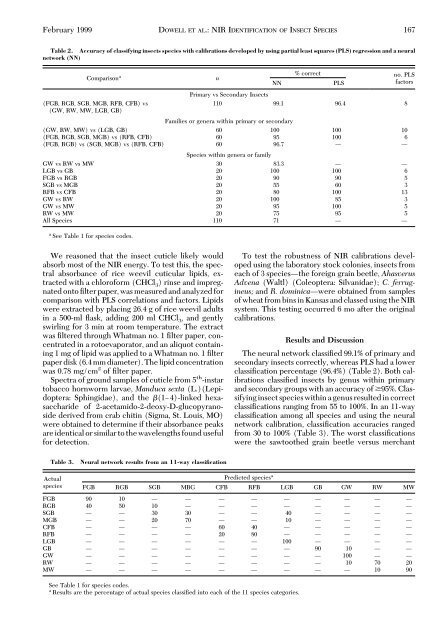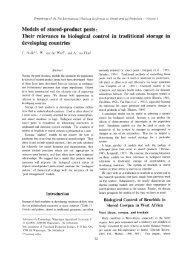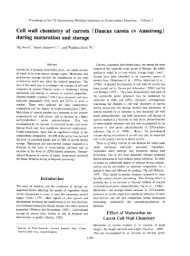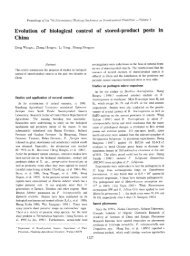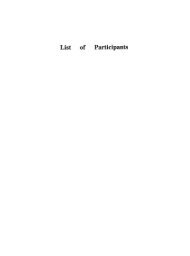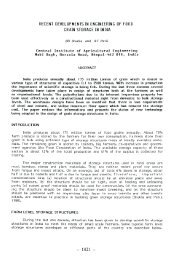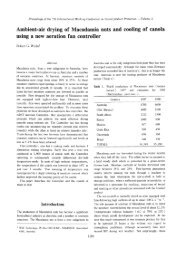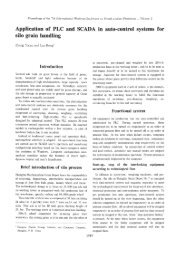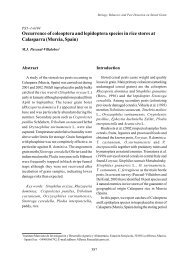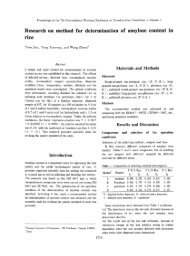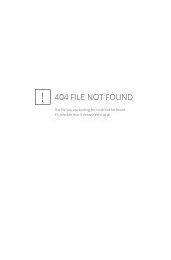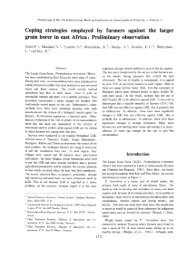Identifying Stored-Grain Insects Using Near-Infrared Spectroscopy
Identifying Stored-Grain Insects Using Near-Infrared Spectroscopy
Identifying Stored-Grain Insects Using Near-Infrared Spectroscopy
Create successful ePaper yourself
Turn your PDF publications into a flip-book with our unique Google optimized e-Paper software.
February 1999 DOWELL ET AL.: NIR IDENTIFICATION OF INSECT SPECIES 167<br />
Table 2. Accuracy of classifying insects species with calibrations developed by using partial least squares (PLS) regression and a neural<br />
network (NN)<br />
Comparisona n<br />
Primary vs Secondary <strong>Insects</strong><br />
NN<br />
% correct<br />
PLS<br />
no. PLS<br />
factors<br />
(FGB, RGB, SGB, MGB, RFB, CFB) vs<br />
(GW, RW, MW, LGB, GB)<br />
110 99.1 96.4 8<br />
Families or genera within primary or secondary<br />
(GW, RW, MW) vs (LGB, GB) 60 100 100 10<br />
(FGB, RGB, SGB, MGB) vs (RFB, CFB) 60 95 100 6<br />
(FGB, RGB) vs (SGB, MGB) vs (RFB, CFB) 60 96.7 Ñ Ñ<br />
GW vs RW vs MW<br />
Species within genera or family<br />
30 83.3 Ñ Ñ<br />
LGB vs GB 20 100 100 6<br />
FGB vs RGB 20 90 90 5<br />
SGB vs MGB 20 55 60 3<br />
RFB vs CFB 20 80 100 13<br />
GW vs RW 20 100 85 3<br />
GW vs MW 20 95 100 5<br />
RW vs MW 20 75 95 5<br />
All Species 110 71 Ñ Ñ<br />
a See Table 1 for species codes.<br />
We reasoned that the insect cuticle likely would<br />
absorb most of the NIR energy. To test this, the spectral<br />
absorbance of rice weevil cuticular lipids, extracted<br />
with a chloroform (CHCl 3) rinse and impregnated<br />
onto Þlter paper, was measured and analyzed for<br />
comparison with PLS correlations and factors. Lipids<br />
were extracted by placing 26.4 g of rice weevil adults<br />
in a 500-ml ßask, adding 200 ml CHCl 3, and gently<br />
swirling for 3 min at room temperature. The extract<br />
was Þltered through Whatman no. 1 Þlter paper, concentrated<br />
in a rotoevaporator, and an aliquot containing<br />
1 mg of lipid was applied to a Whatman no. 1 Þlter<br />
paper disk (6.4 mm diameter). The lipid concentration<br />
was 0.78 mg/cm 2 of Þlter paper.<br />
Spectra of ground samples of cuticle from 5 th -instar<br />
tobacco hornworm larvae, Manduca sexta (L.)(Lepidoptera:<br />
Sphingidae), and the (1Ð4)-linked hexasaccharide<br />
of 2-acetamido-2-deoxy-D-glucopyranoside<br />
derived from crab chitin (Sigma, St. Louis, MO)<br />
were obtained to determine if their absorbance peaks<br />
are identical or similar to the wavelengths found useful<br />
for detection.<br />
Table 3. Neural network results from an 11-way classification<br />
Actual<br />
species<br />
To test the robustness of NIR calibrations developed<br />
using the laboratory stock colonies, insects from<br />
each of 3 speciesÑthe foreign grain beetle, Ahasverus<br />
Advena (Waltl) (Coleoptera: Silvanidae); C. ferrugineus;<br />
and R. dominicaÑwere obtained from samples<br />
of wheat from bins in Kansas and classed using the NIR<br />
system. This testing occurred 6 mo after the original<br />
calibrations.<br />
Results and Discussion<br />
The neural network classiÞed 99.1% of primary and<br />
secondary insects correctly, whereas PLS had a lower<br />
classiÞcation percentage (96.4%) (Table 2). Both calibrations<br />
classiÞed insects by genus within primary<br />
and secondary groups with an accuracy of 95%. Classifying<br />
insect species within a genus resulted in correct<br />
classiÞcations ranging from 55 to 100%. In an 11-way<br />
classiÞcation among all species and using the neural<br />
network calibration, classiÞcation accuracies ranged<br />
from 30 to 100% (Table 3). The worst classiÞcations<br />
were the sawtoothed grain beetle versus merchant<br />
Predicted species a<br />
FGB RGB SGB MBG CFB RFB LGB GB GW RW MW<br />
FGB 90 10 Ñ Ñ Ñ Ñ Ñ Ñ Ñ Ñ Ñ<br />
RGB 40 50 10 Ñ Ñ Ñ Ñ Ñ Ñ Ñ Ñ<br />
SGB Ñ Ñ 30 30 Ñ Ñ 40 Ñ Ñ Ñ Ñ<br />
MGB Ñ Ñ 20 70 Ñ Ñ 10 Ñ Ñ Ñ Ñ<br />
CFB Ñ Ñ Ñ Ñ 60 40 Ñ Ñ Ñ Ñ Ñ<br />
RFB Ñ Ñ Ñ Ñ 20 80 Ñ Ñ Ñ Ñ Ñ<br />
LGB Ñ Ñ Ñ Ñ Ñ Ñ 100 Ñ Ñ Ñ Ñ<br />
GB Ñ Ñ Ñ Ñ Ñ Ñ Ñ 90 10 Ñ Ñ<br />
GW Ñ Ñ Ñ Ñ Ñ Ñ Ñ Ñ 100 Ñ Ñ<br />
RW Ñ Ñ Ñ Ñ Ñ Ñ Ñ Ñ 10 70 20<br />
MW Ñ Ñ Ñ Ñ Ñ Ñ Ñ Ñ Ñ 10 90<br />
See Table 1 for species codes.<br />
a Results are the percentage of actual species classiÞed into each of the 11 species categories.


